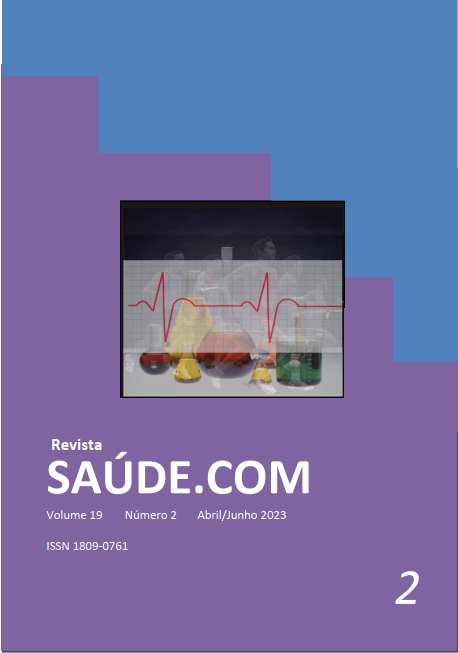Estratégias terapêuticas no manejo do risco suicida
DOI:
https://doi.org/10.22481/rsc.v19i2.12256Palavras-chave:
Suicídio, Ideação Suicida, Terapias, Transtornos do humor, Saúde mentalResumo
Objetivo. Descrever as principais estratégias terapêuticas úteis visando o manejo do risco suicida. Método. Trata-se de uma revisão narrativa, que incluiu artigos publicados entre 2018 e 2023 nas bases de dados PubMed, BVS, SciELO, Periódicos CAPES e Google Scholar. Para as buscas, diversos descritores foram combinados com: “Suicide”, “Suicidal Ideation” e “Ideations, Suicidal”. Resultados. Quanto aos hábitos de vida, destacam-se: qualidade do sono, prática regular de exercícios físicos e senso de identificação e de pertencimento a uma comunidade. Dentre as terapias psicológicas, a Terapia Cognitivo Comportamental (TCC) e a Terapia Comportamental Dialética apresentam melhores evidências. Com relação às medidas farmacológicas e procedimentais, o acompanhamento da condição de base, quando existente, é determinante na escolha da opção terapêutica e destaca-se a importância de redobrar os cuidados com pessoas que já tentaram suicidio. Para transtornos de humor, o Lítio pode proporcionar boa resposta no manejo do risco suicida, além de antidepressivos e da associação deles com terapias psicológicas, sobretudo a TCC. A Cetamina e a eletroconvulsoterapia também são possibilidades promissoras, principalmente pela rápida melhora na crise. Conclusão. Apresentamos um panorama de ferramentas úteis para o cuidado em saúde mental que pode contribuir para otimizar a assistência diante do risco suicida.
Downloads
Referências
World Health Organization. World mental health report. Transforming mental health for all. Geneva: World Health Organization, 2022.
National Institute of Mental Health: Suicide. Disponível em: https://www.nimh.nih.gov/health/statistics/suicide. Acesso em: 29 jan. 2023.
Chan MKY, Bhatti H, Meader N, et al. Predicting suicide following self-harm: systematic review of risk factors and risk scales. British Journal of Psychiatry 2016; 209: 277–283.
Spottswood M, Lim CT, Davydow D, et al. Improving Suicide Prevention in Primary Care for Differing Levels of Behavioral Health Integration: A Review. Front Med 2022; 9: 892205.
Gøtzsche PC, Gøtzsche PK. Cognitive behavioural therapy halves the risk of repeated suicide attempts: systematic review. J R Soc Med 2017; 110: 404–410.
Parasuicide. Edited by N. Kreitman. (Pp. 193; illustrated; £9.95.) John Wiley & Sons: London. 1977. Psychological Medicine 1978; 8: 539–540.
Nabi Z, Stansfeld J, Plöderl M, et al. Effects of lithium on suicide and suicidal behaviour: a systematic review and meta-analysis of randomised trials. Epidemiology and Psychiatric Sciences; 31. Epub ahead of print 2022. DOI: 10.1017/s204579602200049x.
D’Anci KE, Uhl S. Treatments for the Prevention and Management of Suicide. Annals of Internal Medicine 2020; 172: 168.
Rother ET. Revisão sistemática X revisão narrativa. Acta paul enferm 2007; 20: v–vi.
Baethge C, Goldback-Wood S, Mertens S. SANRA - a scale for the quality assessment of narrative review articles. Research Integrity and Peer Review 2019. https://doi.org/10.1186/s41073-019-0064-8
MeSH - NCBI. Disponível em: https://www.ncbi.nlm.nih.gov/mesh/. Acesso em: 16 jan. 2023.
Perlis ML, Grandner MA, Chakravorty S, et al. Suicide and sleep: Is it a bad thing to be awake when reason sleeps? Sleep Med Rev 2016; 29: 101–107.
Kim MJ, Shin D, Ahn YM. Association between the number of hours of sleep during weekdays and suicidality among Korean adolescents: Mediating role of depressive and anxiety symptoms. J Affect Disord 2023; 320: 74–80.
Hamilton JL, Tsypes A, Zelazny J, et al. Sleep influences daily suicidal ideation through affective reactivity to interpersonal events among high‐risk adolescents and young adults. Journal of Child Psychology and Psychiatry 2023; 64: 27–38.
Kalmbach DA, Cheng P, Ahmedani BK, et al. Cognitive-behavioral therapy for insomnia prevents and alleviates suicidal ideation: insomnia remission is a suicidolytic mechanism. Sleep; 45. Epub ahead of print 12 December 2022. DOI: 10.1093/sleep/zsac251.
Kim HJ, Oh SY, Lee DW, et al. The Effects of Intense Physical Activity on Stress in Adolescents: Findings from Korea Youth Risk Behavior Web-Based Survey (2015-2017). Int J Environ Res Public Health; 16. Epub ahead of print 27 May 2019. DOI: 10.3390/ijerph16101870.
Vancampfort D, Hallgren M, Firth J, et al. Physical activity and suicidal ideation: A systematic review and meta-analysis. J Affect Disord 2018; 225: 438–448.
Scarth B, Bering JM, Marsh I, et al. Strategies to Stay Alive: Adaptive Toolboxes for Living Well with Suicidal Behavior. Int J Environ Res Public Health; 18. Epub ahead of print 29 July 2021. DOI: 10.3390/ijerph18158013.
Plöderl M, Kunrath S, Fartacek C. God Bless You? The Association of Religion and Spirituality with Reduction of Suicide Ideation and Length of Hospital Stay among Psychiatric Patients at Risk for Suicide. Suicide Life Threat Behav 2020; 50: 95–110.
Lusk J, Dobscha SK, Kopacz M, et al. Spirituality, Religion, and Suicidality Among Veterans: A Qualitative Study. Arch Suicide Res 2018; 22: 311–326.
Vitale A, Byma L, Sun S, et al. Effectiveness of Complementary and Integrative Approaches in Promoting Engagement and Overall Wellness Toward Suicide Prevention in Veterans. J Altern Complement Med 2021; 27: S14–S27.
Meore A, Sun S, Byma L, et al. Pilot evaluation of horticultural therapy in improving overall wellness in veterans with history of suicidality. Complement Ther Med 2021; 59: 102728.
Gutierrez PM, Johnson L, Podlogar MC, et al. Pilot study of the Collaborative Assessment and Management of Suicidality-Group. Suicide Life Threat Behav 2022; 52: 244–255.
Amadéo S, Nguyen NL, Teai T, et al. Supportive effect of body contact care with ylang ylang aromatherapy and mobile intervention team for suicide prevention: A pilot study. Journal of International Medical Research 2020; 48: 030006052094623.
Roberge EM, Bryan CJ, Peterson A, et al. Variables associated with reductions in insomnia severity among acutely suicidal patients receiving brief cognitive behavioral therapy for suicide prevention. J Affect Disord 2019; 252: 230–236.
Pigeon WR, Funderburk JS, Cross W, et al. Brief CBT for insomnia delivered in primary care to patients endorsing suicidal ideation: a proof-of-concept randomized clinical trial. Transl Behav Med 2019; 9: 1169–1177.
Raj S, Sachdeva SA, Jha R, et al. Effectiveness of mindfulness based cognitive behavior therapy on life satisfaction, and life orientation of adolescents with depression and suicidal ideation. Asian J Psychiatr 2019; 39: 58–62.
Schmelefske E, Per M, Khoury B, et al. The Effects of Mindfulness-Based Interventions on Suicide Outcomes: A Meta-Analysis. Arch Suicide Res 2022; 26: 447–464.
Esposito-Smythers C, Wolff JC, Liu RT, et al. Family-focused cognitive behavioral treatment for depressed adolescents in suicidal crisis with co-occurring risk factors: a randomized trial. J Child Psychol Psychiatry 2019; 60: 1133–1141.
Mehlum L, Ramleth R-K, Tørmoen AJ, et al. Long term effectiveness of dialectical behavior therapy versus enhanced usual care for adolescents with self-harming and suicidal behavior. J Child Psychol Psychiatry 2019; 60: 1112–1122.
D’Anci KE, Uhl S, Giradi G, et al. Treatments for the Prevention and Management of Suicide: A Systematic Review. Ann Intern Med 2019; 171: 334–342.
Peñas-Lledó EM, Guillaume S, de Andrés F, et al. A one-year follow-up study of treatment-compliant suicide attempt survivors: relationship of CYP2D6-CYP2C19 and polypharmacy with suicide reattempts. Transl Psychiatry; 12. Epub ahead of print 2022. DOI: 10.1038/s41398-022-02140-4.
Kringen MK, Bråten LS, Haslemo T, et al. The Influence of Combined CYP2D6 and CYP2C19 Genotypes on Venlafaxine and O-Desmethylvenlafaxine Concentrations in a Large Patient Cohort. J Clin Psychopharmacol; 40. Epub ahead of print 2020. DOI: 10.1097/JCP.0000000000001174.
Paris J. Suicidality in Borderline Personality Disorder. Medicina ; 55. Epub ahead of print 28 May 2019. DOI: 10.3390/medicina55060223.
Saigle V, Racine E. Ethical challenges faced by healthcare professionals who care for suicidal patients: a scoping review. Monash Bioeth Rev 2018; 35: 50–79.
Zhou X, Teng T, Zhang Y, et al. Comparative efficacy and acceptability of antidepressants, psychotherapies, and their combination for acute treatment of children and adolescents with depressive disorder: a systematic review and network meta-analysis. The lancet Psychiatry; 7. Epub ahead of print July 2020. DOI: 10.1016/S2215-0366(20)30137-1.
Chin T, Huyghebaert T, Svrcek C, et al. Traitement antidépresseur personnalisé pour les patients souffrant d’un trouble dépressif caractérisé: Outil novateur d'aide à la décision fondée sur des données probantes. Can Fam Physician 2022; e301–e309.
Stahl SM. Fundamentos de psicofarmacologia de Stahl: guia de prescrição. 6. ed. Porto Alegre: Artmed, 2018. 313 p.
Qriouet Z, Qmichou Z, Bouchoutrouch N, et al. Analytical Methods Used for the Detection and Quantification of Benzodiazepines. J Anal Methods Chem; 2019. Epub ahead of print 2019. DOI: 10.1155/2019/2035492.
Dold M, Bartova L, Fugger G, et al. Add-on benzodiazepine treatment in patients with major depressive disorder – results from a European cross-sectional multicenter study. Eur Neuropsychopharmacol 2020; 41: 70–80.
Sung HG, Li J, Nam JH, et al. Concurrent use of benzodiazepines, antidepressants, and opioid analgesics with zolpidem and risk for suicide: a case-control and case-crossover study. Soc Psychiatry Psychiatr Epidemiol; 54. Epub ahead of print December 2019. DOI: 10.1007/s00127-019-01713-x.
McIntyre RS, Berk M, Brietzke E, et al. Bipolar disorders. Lancet; 396. Epub ahead of print 5 December 2020. DOI: 10.1016/S0140-6736(20)31544-0.
Wortzel HS, Simonetti JA, Oslin DW, et al. Lithium Use for Suicide Prevention, Revisited. J Psychiatr Pract 2023; 51–57.
Warriach ZI, Sanchez-Gonzalez MA, Ferrer GF. Suicidal Behavior and Medication Adherence in Schizophrenic Patients. Cureus; 13. Epub ahead of print January 2021. DOI: 10.7759/cureus.12473.
Khokhar JY, Henricks AM, Kirk E, et al. Unique Effects of Clozapine: A Pharmacological Perspective. Adv Pharmacol 2018; 82: 137.
Gales A, Maxwell S. Cetamina: Evidências Recentes e Usos Atuais. Anesthesia tutorial of the week 2018. https://www.sbahq.org/wp-content/uploads/2018/07/381_portugues.pdf (accessed 8 February 2023).
Corriger A, Pickering G. Ketamine and depression: a narrative review. Drug Des Devel Ther 2019; 13: 3051.
Laguna GGC, de Carvalho LS, de Azevedo KRM. Eletroconvulsoterapia no manejo do risco suicida. Rev Neurocienc 2022; 30: 1–19. https://doi.org/10.34024/rnc.2022.v30.14294
Rönnqvist I, Nilsson FK, Nordenskjöld A. Electroconvulsive Therapy and the Risk of Suicide in Hospitalized Patients With Major Depressive Disorder. JAMA network open; 4. Epub ahead of print 1 July 2021. DOI: 10.1001/jamanetworkopen.2021.16589.
Kaster TS, Vigod SN, Gomes T, et al. Risk of serious medical events in patients with depression treated with electroconvulsive therapy: a propensity score-matched, retrospective cohort study. The lancet Psychiatry; 8. Epub ahead of print August 2021. DOI: 10.1016/S2215-0366(21)00168-1.
Downloads
Publicado
Como Citar
Edição
Seção
Licença
Copyright (c) 2023 Revista Saúde.com

Este trabalho está licenciado sob uma licença Creative Commons Attribution 4.0 International License.







